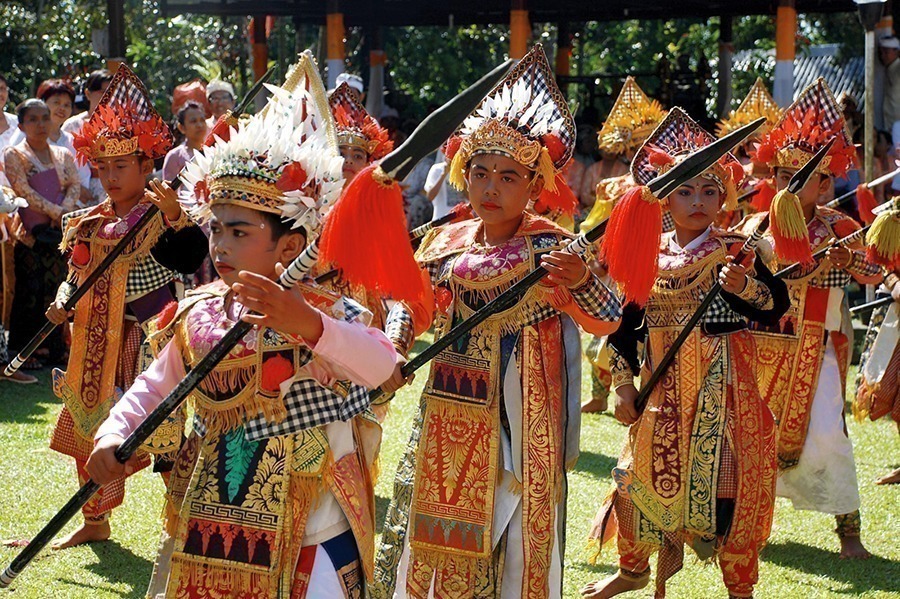Baris Dance is one of the most important sacred dance on Bali island. The dance’s name is taken from the uptake ‘bebarisan’ word, which means ‘a file line formation’ literally. Which is also closely related to the warrior of ancient Balinese Kingdom, who served as soldiers in general.
Baris is famous as a warrior or patriotic dance as well, in addition to its function as a ritual dance. Only men allowed to perform this dance and usually in a group with the number between four to sixty people.
Shows the physical toughness of a man is the nature of this dance ritual. Evidenced by the maturity of the military skills such as discipline and the use of weapons (spear). This dance is usually performed only in religious rituals such as Galungan and Kuningan, and also in the Temples during the Hindu Bali ceremonies.
Baris Dance staging in the largest temple in Bali, Besakih, performed at a regular intervals time every year on the full moon, according to the Balinese calendar. The dance is unique in firmly character and discipline on each body movements and shrewdness in using spear weapon. The dancers use a unique costume with a loop or triangle-shaped head cover with unique Balinese ornaments, some scarf with gold thread called ‘lelamakan’ or ‘awiran’, which they use to cover their shirt.
Black , red, white are proffered. The shoulder is covered by bapang, an elaborate neck band full of coloured stones. A stagen or long tie is wrapped around his chest hold the keris or the dagger on his back. This keris becomes his weapon , especially in the baris melampahan or dramatic baris that will be described then.
The baris dance is usually accompanied by the traditional Balinese musical orchestra, know as Gambelan, which consists of a group of musicians and is maintained primarily for temple ceremonies and accompanies the baris and other Bali’s dances. Instruments commonly used include metallophones, gongs, flute , rebab and drum all essential of a percussion orchestra. There are several kinds of baris dances in Bali which are usually named based on the weapon used in the dance:
Baris Tumbak
Baris Tumbak uses a wepon called tumbak (long spear tipped with a peacock feather). The dance is performed in double lines of twelve to twenty dancers, grimacing and striking heroic poses. When the music becomes violent the dancers enact a sham battle with their tumbak . This baris is accompanied by Gambelan Gong.
Baris Presi
The dancer of Baris Presi or knobbed shield of painted and gilled leather with a wavy edge, held at back by wooden handle. The baris presi is performed by eight men in close file with small circles and accompanied by the Gambelan Gong .This baris is characteristical from southern Bali with its swift turns, long stances on one leg, dips, long pauses, swift eye movements, the seledet and familiar baris cry.
Baris Jojor
Baris Jojor is equipped by a jojor (a type of lance) . It is usually performed by eight dancer and has more dance movent than the baris tumbak. The accompaniment of this baris is the Gambelan Tembang Kirang, four slendro tones of Balinese orchestra.
Baris Dadap
The weapon of Baris Dadap is called dadap, a curious wedge shaped pointed shield, curled over , just like a sleigh and formed in pairs, starting with four to sixteen dancers. The accompaniment of this baris is also gambelan Tembang Kirang, the four tones of Balinese Orchestra.
Baris Panah
Panah is the Balinese word for bow and arrow. This military weapon is used by Baris Panah and the dance is performed by some tarunas (young men) found in north Bali. Its costumes are simpler than other baris. Its accompaniment is the Gambelan Tembang Kirang.
Baris Omang
The dancers of Baris Omang bring with them a weapon called omang, a type of shield. It is performed by eight dancers. They form two rows, first kneel, then rise and stand facing inward each other. They slowly shift their shield and prepare for the fight.
Baris Pendet
In the Baris Pendet, the accent is on the offering, however there is always an element of battle. There are many varieties of this dance. In performancing yhis dance, the dancers are in fact praying to God. This dance is generally performed by several boys. In their hand they carry offering of flowers on silver bowls. This dance is more elaborately danced than other ceremonial baris.
Baris Tamiang
Baris Tamiang is another version of the baris presi, where the dancers carry with them a weapon called tamiang (shiekd) This dance is also performed in pairs and the accompaniment is the Gambelan Gong.
Baris Melambahan
Baris Melambahan is most the impressive and brilliant one. This is indeed a form of Balinese dance drama which is representative of the baris dance. This drama, the story of which comes from Ramayana and Mahabrata, the two story great Indian epies, contains dialogue. When this baris is performed by a single dancer, he represents one of the heroes in Ramayana, Mahabrata or any other stories. This baris melambahan itself as a whole is considered typical of a strong male character.


